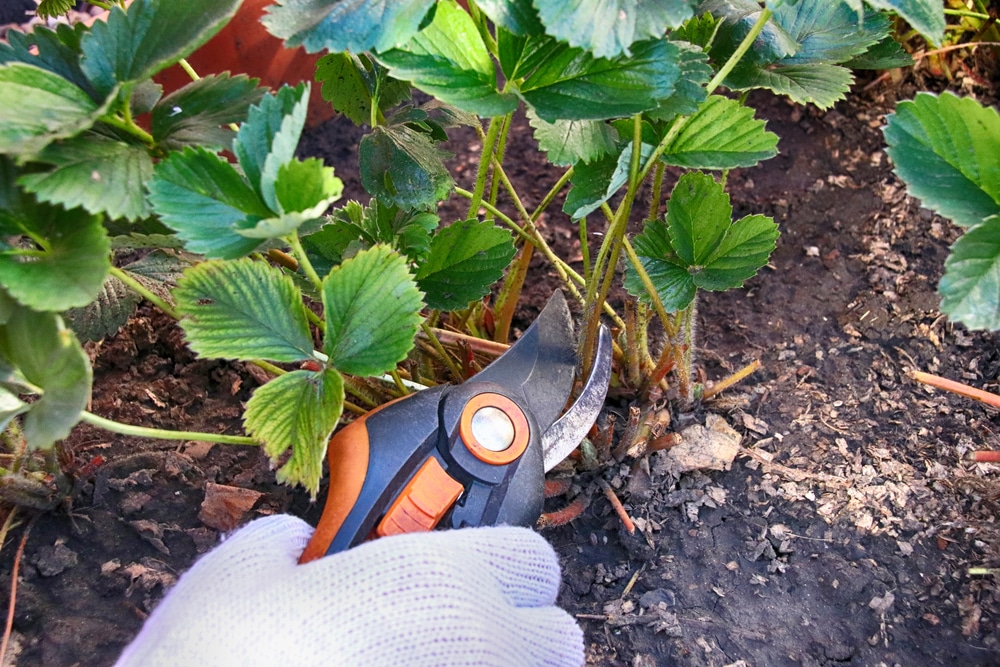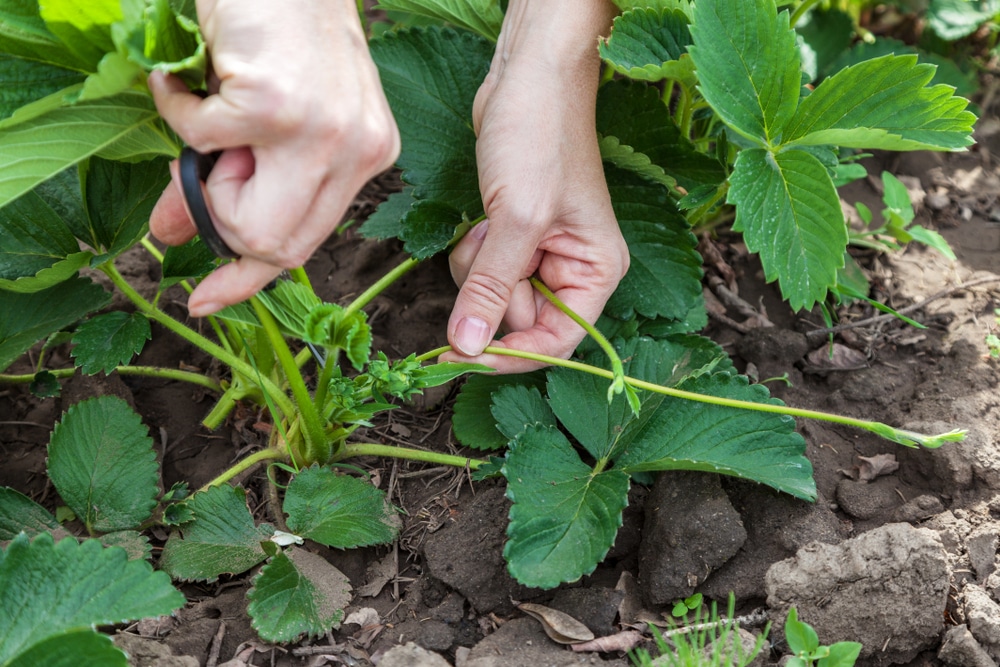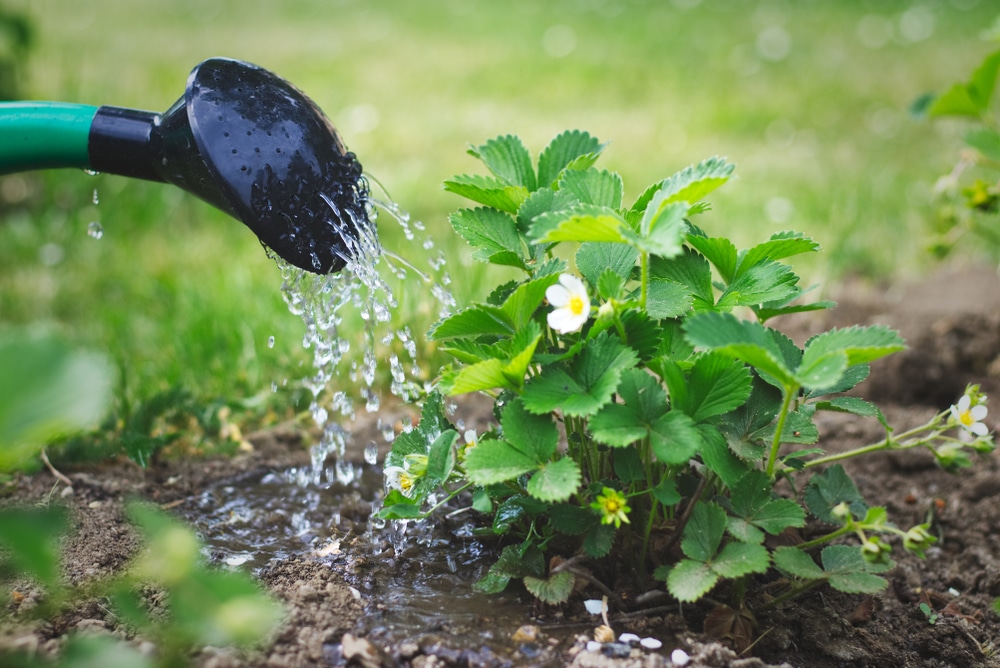Log in or create new account to save this product to your wishlist.

Pruning Strawberries: Why, When & How
Pruning strawberries 101: A simple guide to a bountiful harvest. Learn the essential steps for best results.
Pruning strawberries forms an important routine for any gardener who dreams of a bountiful harvest of juicy strawberries. By applying the right pruning techniques, you can promote the growth and fruiting of the plants. In this article, you’ll get a comprehensible guide to pruning strawberry plants so that you can enjoy a bountiful harvest.
- Why is pruning strawberries so important?
- When to cut back strawberry plants in UK?
- Step-by-step guide to pruning strawberries
- Common mistakes when cutting back strawberries
- How many are too many leaves on strawberry plants?
- Tips to keep your strawberry plants healthy
- Other important tips to care for your strawberry plants
- Troubleshooting Strawberry Plants
- FAQs about pruning strawberries
- Ready to prune strawberries for a bountiful harvest?
Why is pruning strawberries so important?
Pruning strawberry plants is important for several reasons. Firstly, it helps in encouraging healthy growth of the plants. By removing old, damaged, or diseased leaves and branches, you keep your plants healthy and prevent the spread of disease.
In addition, pruning strawberries promotes the fruiting of the plants. By removing excess leaves and runners from strawberries, the plants can focus their energy on producing healthy and juicy strawberries.
When to cut back strawberry plants in UK?
Prune your strawberry plants after they have finished fruiting in late summer to early autumn. The best time to prune strawberries depends on the type of plant. Usually, you should cut your strawberries in mid-July or latest at the end of July. Some kinds, however, bear fruits until autumn. Then you should only carefully remove old growth, as they don’t get much time to recover before winter.

In the following spring, the focus for these strawberries shifts to removing any dead or damaged foliage that has emerged over the winter and preparing the plants for the upcoming growing season. This might also include thinning out any excess runners that have formed and are not wanted for new plantings.
You can also prune the strawberry plant in the winter, especially if you notice that the plants have started to grow too close together. By removing excess runners and leaves, you can give the plants better air circulation and thus reduce the risk of fungal diseases.
Step-by-step guide to pruning strawberries
Here’s a step-by-step guide on how to prune strawberries:
- Remove leaves
Start by removing old, damaged, or diseased leaves and branches. Use sharp pruning shears to prune the strawberries. Cut the leaves and branches as close to the base of the plant as possible.
- Snip runners
Remove excess runners. Pick out the healthiest runners and carefully cut them with sharp pruning shears. Leave about three to four runners per plant to promote growth and fruiting.
- Thin out plants
If the strawberry plants are growing too close together, remove some of the plants to create enough space for healthy growth. When doing this, make sure to remove the weakest plants and keep the stronger ones.
- Trim summer bearers
When needed, trim the leaves of the summer bearers—plants that produce fruit in the warmer months. Snip them approximately ten centimetres from the top of the plant. This action encourages fresh growth, as it boosts the plant’s capacity to photosynthesise and sprout new foliage.

Common mistakes when cutting back strawberries
While tending to strawberries, certain frequent blunders can put a plentiful yield at risk. Primarily, it’s crucial not to eliminate an excessive number of leaves and runners. When trimming strawberries, the key is to strike an equilibrium between getting rid of surplus growth and preserving an adequate number of leaves and offshoots for a vigorous plant.
Another frequently occurring misstep is trimming strawberries at an inappropriate time, more precisely, too early during springtime. Therefore, hold off until the frost has cleared, and the plants begin to bud before shearing them. Trimming at an unsuitable time can hinder the plant’s growth and fruit-bearing capacity.
How many are too many leaves on strawberry plants?
The thing with leaves is, they provide energy to the plant through photosynthesis, but they also cost significant effort to maintain. You can help your strawberry plant by removing leaves that don’t get much sunlight or grow too thick. The number of leaves if not the key here. Just take a general look and trust your gut. Or have a look at the strawberry plant in your garden that has the best strawberry yield and model the others after it.
Tips to keep your strawberry plants healthy
In addition to pruning your strawberries, there are also a number of other important tips for caring for your strawberry plants and maintaining their health. Here are some valuable tips:
- Make sure you have good irrigation. After all, strawberry plants need regular watering, especially during dry periods. Make sure to keep the soil moist at all times, but avoid overwatering as it can lead to root rot.
- Check regularly for pests and diseases. So keep a close eye on your plants and take measures to control pests and diseases if necessary.
- Fertilise your plants frequently. To accomplish this, use a balanced fertiliser rich in nitrogen, phosphorus, and potassium to promote the growth and fruiting of the strawberry plants.

Other important tips to care for your strawberry plants
Not only do you need to prune and take good care of your strawberries, there are also a number of other essential tasks that you need to do if you want to increase your chances of a bountiful harvest.
One of these tasks is mulching the strawberry beds. By applying a layer of organic mulching material around the plants, you can stop the growth of weeds, maintain good moisture in your soil, and promote fruit set.
Another task is to regularly check and remove diseased or damaged strawberries. This helps to prevent the spread of disease and maintain the health of the plants.
Troubleshooting Strawberry Plants
Sometimes problems can arise with strawberry plants, such as diseases, pests, or lack of fruiting. Here are some possible solutions to the most common problems.
For pests and diseases, you can use biological control methods, such as using insecticides based on natural ingredients or introducing beneficial insects into the garden.
If the strawberry plants don’t set fruit well, you can try to promote pollination by attracting bees and other pollinating insects. Plant flowers that attract bees near the strawberry plants.
FAQs about pruning strawberries
To maintain strawberries optimally, prune old leaves and runners regularly. Make sure you have plenty of sunlight and moist, well-drained soil. Use organic fertilisers and check for diseases regularly. Follow these simple steps for a healthy strawberry harvest.
Prune strawberries just above the crown once they are completely red and firm to the touch. Use sharp pruning shears to limit damage. Pick your strawberries regularly to promote growth and enjoy fresh, flavourful strawberries from your own garden.
Use the runners of strawberries by rooting them in soil next to the mother plant. After rooting, separate and transplant them to a new location for expansion of your strawberry bed. This will increase your yield and maintain healthy plants at the same time.
Ready to prune strawberries for a bountiful harvest?
Pruning strawberries is a must for any strawberry grower. A bountiful harvest of juicy strawberries will be your reward. So, follow our step-by-step guide, avoid common mistakes, and enjoy the delicious fruits of your efforts.
If you’re looking for yet another enchantingly beautiful plant that attracts not only masses of bees but also butterflies, find out how to easily plant and care for lavender. Or learn all the ins and outs of how to prune a fig tree like a pro. Do you have any questions or need more advice? You are welcome to leave a comment or contact us.
Happy pruning and harvesting!
-
Orchids: A Complete Guide on How to Care for ThemWant to give your orchid the best possible care? Discover essential tips from placement to watering and pruning. Learn everything you need to know!Read more
-
Growing Wisteria Made Simple: From Planting to Perfect BloomsWith blossoms like a purple waterfall, Wisteria sets an almost magical and colourful mood. If you want to grow this beauty in your garden, you’ll need a bit of patience. Don’t worry, it will most definitely pay off.Read more
-
How to Build a DIY Greenhouse: A Practical Guide for Smart SpendersImagine extending your growing season throughout the year, nurturing tender plants regardless of the weather, and creating a personal garden sanctuary. This is precisely what a DIY greenhouse offers you. Let’s learn how to build one.Read more
-
How to Grow Eucalyptus in British GardensWith a little love and care, eucalyptus trees can thrive in English gardens. Since they don’t germinate well without proper help, there are not considered invasive. So, there is no reason not to plant them if you enjoy their looks.Read more
-
Transform Your Garden with All-Year-Round Flowering PlantsDid you know you can enjoy blooming flowers even in January? With the right selection of all year round plants, there’s no need to wait until spring to add some colour to your garden.Read more
-
How to Create a Butterfly Garden: A Simple Guide for British GardensThe UK's butterfly population includes 59 different species. These beautiful winged creatures face a steady decline because of habitat loss, pollution and changing weather patterns. Your garden can become a vital link between nature reserves and natural habitats. Let’s explore how.Read more
-
Volcanic Rock Dust for Your Garden—Application and TipsDid you know that volcanic rock dust is a brilliant organic soil improver? This article explains exactly what it's good for and how to use it properly.Read more
-
How to Use Landscape Fabric ProperlyIf weeds or erosion in your garden are troubling you, landscape fabric might be the solution. We’ll explain how and when to use it properly, just keep on reading.Read more
Leave a comment
Your answer will be displayed on the site and the interested party will be notified by email.
Leave a comment
Have a question or want to share your experience? Leave us a comment.

- Order by 2PM = shipped today
- 250.000+ satisfied customers!
- 60 day satisfaction guarantee

- Order by 2PM = shipped today
- 250.000+ satisfied customers!
- 60 day satisfaction guarantee

🌱 All important maintenance moments for your lawn during the year. Leave your email and we will send you the lawn calendar for free.
Enter your email
Receive the lawn calendar in the mail
Enjoy a green lawn all year round!






















Comments (0)
There are no comments yet. Well then, what are you waiting for to
Be the first to write your comment!inaugurate this pretty page?
Do you have some comments?